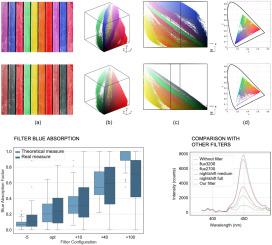利用一种新颖的色彩空间变换,提出了一种优化的自适应蓝光滤波方法
IF 3.4
2区 工程技术
Q1 COMPUTER SCIENCE, HARDWARE & ARCHITECTURE
引用次数: 0
摘要
可穿戴屏幕是日常生活的一部分,但它们发出的蓝光会影响人体。高能蓝光被称为“蓝色危害”,与昼夜节律紊乱、注意力下降、认知功能和计算机视觉综合症有关。随着屏幕离眼睛越来越近,特别是对于已经患有眼部疾病的用户来说,有效的过滤变得越来越重要。这项工作提出了一种蓝光滤光器,它可以在一种新的色彩空间中处理图像,选择性地减少高能像素,同时保留大多数颜色。经过过滤后,对比度和图像质量几乎保持不变,根据几个广泛使用的指标。物理测量表明,蓝光的吸收超出了理论预期。在各种屏幕上进行的分光光度测试显示出一致的性能-通常在色差(ΔE)为10时减少30%-40%的蓝光,吸收率高达100%。与f.lux和Night Shift相比,我们的过滤器分别减少了17%和34%的蓝色排放。使用基本并行化(高达85 Hz),每张图像的平均处理时间为0.012 s,非常适合现代可穿戴设备和电子设备。本文章由计算机程序翻译,如有差异,请以英文原文为准。

An optimized, color-adaptive blue light filtering approach using a novel color space transformation
Wearable screens are part of everyday life, but the blue light they emit can affect the human body. Known as the Blue Hazard, high-energy blue light has been linked to circadian rhythm disruption, reduced focus, cognitive functions, and Computer Vision Syndrome. As screens move closer to the eyes, especially in users with pre-existing eye conditions, effective filtering becomes increasingly important.
This work presents a blue light filter that processes images in a novel color space, selectively reducing high-energy pixels while preserving most colors. After filtering, both contrast and image quality remain virtually unchanged, according to several widely used metrics.
Physical measurements showed that blue light absorption exceeded theoretical expectations. Spectrophotometric tests across various screens demonstrated consistent performance—typically reducing 30%–40% of blue light for a color difference () of 10, with absorption reaching up to 100%. Compared to f.lux and Night Shift, our filter reduces blue emissions by 17% and 34% more, respectively. With an average processing time of 0.012 s per image using basic parallelization (up to 85 Hz), it is well-suited for modern wearable and electronic devices.
求助全文
通过发布文献求助,成功后即可免费获取论文全文。
去求助
来源期刊

Displays
工程技术-工程:电子与电气
CiteScore
4.60
自引率
25.60%
发文量
138
审稿时长
92 days
期刊介绍:
Displays is the international journal covering the research and development of display technology, its effective presentation and perception of information, and applications and systems including display-human interface.
Technical papers on practical developments in Displays technology provide an effective channel to promote greater understanding and cross-fertilization across the diverse disciplines of the Displays community. Original research papers solving ergonomics issues at the display-human interface advance effective presentation of information. Tutorial papers covering fundamentals intended for display technologies and human factor engineers new to the field will also occasionally featured.
 求助内容:
求助内容: 应助结果提醒方式:
应助结果提醒方式:


